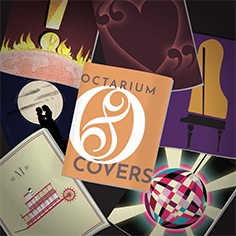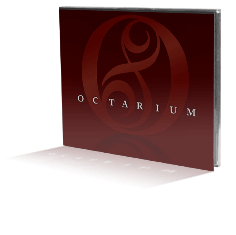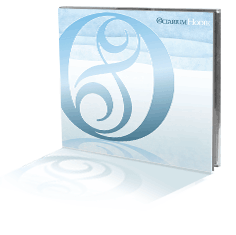
The voice is a unique instrument; the only instrument that you carry with you at all times, whether you want to or not. It is also one of the most unpredictable and malleable instruments; no buttons to push, no spit valves to shake out, no strings to replace; you can’t buy a new one, can’t get it tuned, can’t get it rebuilt. What you have, you have. Luckily, the eight singers of Octarium have it. In spades. So it only makes sense to have these talented singers offer their voices to pieces that no one ever imagined as vocal pieces.
2010-2011 Octarium Covers
Released in 2020 and recorded in 2010-2011, the selections on Octarium’s new release, “Covers” were inspired by our “Should Have Been Choral” concert program.
| 1 | Proud Mary | |
| 2 | Dancing Queen | |
| 3 | When You Say Nothing At All |
With each track, it becomes more clear that Octarium’s debut album Octarium is a release to be savored and shared.
| 1 | Rise Up My Love | Willan |
| 2 | O Quam Gloriosum | Victoria |
| 3 | Triptych – Musick’s Empire | Pfautsch |
| 4 | Triptych – Orpheus With His Lute | Pfautsch |
| 5 | Triptych – Consecrate the Place and Day | Pfautsch |
| 6 | Cantate Domino | Monteverdi |
| 7 | The Willow Song | Vaughan Williams |
| 8 | For Thy Sweet Love | Young |
| 9 | Missa Brevis – Kyrie | Hatfield |
| 10 | Missa Brevis – Agnus Dei | Hatfield |
| 11 | Hymn to St. Cecilia – Mvt I | Britten |
| 12 | Hymn to St. Cecilia – Mvt II | Britten |
| 13 | Hymn to St. Cecilia – Mvt III | Britten |
| 14 | My Shepherd Will Supply My Need | Arr. Thomson |
| 15 | Wondrous Love | Arr. Parker/Shaw |
| 16 | Let All Mortal Flesh Keep Silence | Bairstow |
| 17 | Jesus Christ the Apple Tree | Poston |
| 18 | Pilgrims’ Hymn from Three Hermits | Paulus |
| 19 | If Ye Love Me | Tallis |
| 20 | Shenandoah | Arr. Erb |
| 1 | Veni, Veni Emmanuel | |
| 2 | Carol of the Rose/ave Maria | |
| 3 | Most Highly Favored Lady | |
| 4 | Still, Still, Still | |
| 5 | What Child Is This | |
| 6 | Long, Long Ago | |
| 7 | Hodie Christus Natus Est | |
| 8 | Quatre Motets Pour Le Temps de Noel | O Magnum Mysterium |
| 9 | Quatre Motets Pour Le Temps de Noel | Quem Vidistis Pastores |
| 10 | Quatre Motets Pour Le Temps de Noel | Videntes Stellam |
| 11 | Quatre Motets Pour Le Temps de Noel | Hodie Christus Natus Est |
| 12 | I Wonder As I Wonder | |
| 13 | The Wexford Carol | |
| 14 | In Dulci Jubilo | |
| 15 | O Magnum Mysterium |
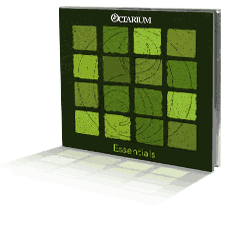
| 1 | El Grillo | Josquin |
| 2 | Ubi Caritas | Duruflé |
| 3 | Sanctus & Benedictus from Mass for Four Voices | Byrd |
| 4 | Bogoroditse Devo, raduysya from Vespers | Rachmaninov |
| 5 | Nunc Dimittis | Gretchaninov |
| 6 | Sicut Cervus | Palestrina |
| 7 | The Blue Bird | Stanford |
| 8 | Ecco mormorar l’onde | Monteverdi |
| 9 | Sing Me to Heaven | Gawthrop |
| 10 | Alleluia | Thompson |
| 11 | Exultate Justi | Viadana |
| 12 | Os Justi | Bruckner |
| 13 | Sanctus from Simple Mass | Lotti |
| 14 | Agnus Dei | Barber |
| 15 | Alleluia | Manuel |
| 16 | Fa Una Canzona | Vecchi |
| 17 | Zum Sanctus from Deutsche Messe | Schubert |
Liner Notes
Love brought us together — love of music. Octarium exists primarily because these eight singers find great pleasure in the incredible music they are able to make together.
That same love prompted the idea for Essentials; love of music and our wish to share that love with you, our audience. This recording features a-cappella music we think all lovers of the choral art should know and appreciate. Designed for students who are learning the standard choral repertoire as well as former students who may need to be reminded how much phenomenal music there is in the world, we hope this concert will kindle, or re-kindle, listeners’ love affair with the choral voice.
There is so much wonderful choral music. This CD represents only a taste of the rich and vast choral repertoire that can touch hearts and souls. We hope this small morsel will inspire. Enlighten. Educate, even.
Krista Lang Blackwood – artistic director
Texts, Translations and Notes
Instrumental music often serves to imitate events and experiences outside the musical realm. Josquin des Prez ((c. 1440 – 1521) provides a rare example of how vocal music can do the same thing with his “El Grillo.” One of the most well-known pieces of the late 15th century, El Grillo imitates of the chirps of a cricket. The piece may have been intended to make a joke of the vocal ability of a singer named Carlo Grillo, who, with Josquin, was under the Sforza patronage in the 1470s.
El Grillo Josquin des Prez (c. 1440 – 1521)
El grillo è buon cantore The cricket is a good singer Che tiene longo verso. He can sing very long. Dalle beve grillo canta. He sings all the time. Ma non fa come gli altri uccelli. But he isn’t like the other birds. Come li han cantato un poco, If they’ve sung a little bit Van de fatto in altro loco They go somewhere else Sempre el grillo sta pur saldo. The cricket always remains where he is. Quando la maggior el caldo When the heat is very fierce Al’hor canta sol per amore. Then he sings only for love.
The mysteries of Gregorian chant — music designed to commune with God on the deepest metaphysical levels — has been an endless source of inspiration for composers. Maurice Duruflé’s (1902 – 1986) setting of “where charity and love prevails” translates the ethereal beauty of the original melody into a setting that speaks easily to our modern ears. Duruflé’s “Ubi Caritas” is often lauded as one of the most, if not the most, perfect expressions of chant retold in 20th century language.
Ubi Caritas Maurice Duruflé (1902 – 1986)
Ubi caritas et amor, Deus ibi est. Where charity and love are, God is there. Congregavit nos in unum Christi amor. Christ’s love has gathered us into one. Exultemus, et in ipso iucundemur. Let us rejoice and be pleased in Him. Timeamus, et amemus Deum vivum. Let us fear, and let us love the living God. Et ex corde diligamus nos sincero. And may we love each other with a sincere heart.
The sanctus and benedictus are sections of the Mass; musical movements of the Ordinary, the parts of the Roman Catholic Mass that remain the same from day to day throughout the church year, as distinct from the Proper, which changes daily according to the liturgical occasion. William Byrd (c. 1539-1623) was an organist and member of protestant Elizabeth I’s private religious establishment, the Chapel Royal. Despite his service to the queen, he remained throughout his life a dedicated Roman Catholic. The queen, apparently out of love for him and his music, tended to turn a blind eye, and Byrd was never seriously threatened for his faith and beliefs. He wrote several settings of the Ordinary of the Mass, one of the most famous of which is the Mass for Four Voices.
Sanctus and Benedictus from Mass for Four Voices William Byrd (c. 1539 – 1623)
Sanctus, Sanctus, Sanctus, Dominus Deus Sabaoth. Holy, Holy, Holy, Lord God of Hosts. Pleni sunt coeli et terra Gloria tua. Heaven and earth are full of your glory. Osanna in excelsis. Hosanna in the highest.
Benedictus qui venit Blessed is He that comes in nomine Domini. in the name of the Lord. Osanna in excelsis. Hosanna in the highest.
Designed to show a sense of beauty in the setting sun, the new light of the coming day and the eternal light of the heavenly kingdom, the all-night vigil is celebrated on the eve of the main feasts of the Orthodox Church. Originally it lasted all night from 6 p.m. on Saturday night through to 9 a.m. on Sunday morning, consisting of three separate services: Great Vespers, Matins and Prime. Sergei Rachmaninov’s (1873 – 1943) setting of the All-Night Vigil, now referred to as Vespers, (Vsenoshchnoye bdeniye op. 37) was written in January and February 1915, while he was traveling throughout Russia concertizing to benefit the war effort. “Bogoroditse Devo” is the last movement of the Vespers portion of the all-night vigil. Rachmaninov’s setting shows the influence of Russian Orthodox music (though it strays from typical chant melody) combined with lush harmonies fitting for a composer considered as the last of the Russian Romantic tradition.
Bogoroditse Devo, raduysya from Vespers Sergeï Vassilievitch Rachmaninov (1873-1943)
Bogoroditse Devo, raduisya Rejoice, virgin mother of God Blagodatnaya Marie, Gospod s Tovoyu Mary full of grace, the Lord is with you Blagoslovena Tyi v zhenakh Blessed are you among women, i blagosloven plod chreva Tvoego, and blessed is the fruit of your womb, yako Spasa rodila esi dush nashikh for you have borne the Savior of our souls.
Alexandre Gretchaninov’s (1864 – 1956) setting of Vespers precedes Rachmaninov’s setting by three years. First performed in Moscow on 18 November 1912, the premiere was less than successful, and the piece did not find a home for itself in the repertoire. Censorship prevented its performance in the Soviet period, and it is rarely performed in Russia today. “Nunc dimittis,” (Op 34 No 1, the Song of Simeon from Vespers) shows Gretchaninov at his best; vivid, bold and epic.
Nunc Dimittis Alexandre Tikhonovitch Gretchaninov (1864-1956)
Lord, now lettest thou thy servant depart in peace According to thy word. For mine eyes have seen thy salvation, Which thou hast prepared before the face of all people; To be a light to lighten the Gentiles And to be the glory of thy people Israel.
During Giovanni Pierluigi Palestrina’s (c.1525 – 1594) life, the Council of Trent nearly banned polyphony in Catholic worship, decreeing that the clarity of the scriptural words should be the first priority. Toward the end of his career, Palestrina composed music that was a compromise between polyphony and the concerns of the Council. Exemplifying the stile antico, Palestrina’s church music embraces the clarity of individual melodic lines and only allows dissonance to last for a short duration on unaccented beats. The result of these rules is a sublimely polyphonic texture heard in the motet “Sicut Cervus,” a setting of Psalm 42:1. “Sicut cervus” is by many accounts the most outstanding example of religious choral art from the Renaissance.
Sicut Cervus Giovanni Pierluigi Palestrina (c.1525 – 1594)
Sicut cervus desiderat ad fontes aquarum As the hart pants after the water brooks ita desiderat anima mea ad te, Deus so pants my soul after you, O God.
Charles Villiers Stanford (1852-1924) was born and raised in Dublin. Active as a composer and conductor, he may be best remembered as a teacher; he was a professor of composition at the Royal College of Music and at Cambridge, where he taught, among others, Ralph Vaughan Williams, Gustav Holst and Herbert Howells. Stanford’s “The Bluebird” is a partsong setting of a simple yet powerful text by Mary Coleridge (1861-1907) describing blue hues of a bird, the sky and the reflection of both in a lake. This is Stanford at his best – crafting an exquisite miniature that depicts color in the realm of sound.
The Blue Bird C.V. Stanford (1852 – 1924)
The lake lay blue below the hill, O’er it, as I looked, there flew Across the waters, cold and still, A bird whose wings were palest blue. The sky above was blue at last, The sky beneath me blue in blue, A moment, ere the bird had passed, It caught his image as he flew.
Claudio Monteverdi (1567 1643) is often credited for bridging the Renaissance period to the Baroque. He spent most of his creative life as the maestro di capella of St. Mark’s Basilica in Venice but wrote prolifically in all contemporary styles. “Ecco mormorar l’onde,” from his second book of Madrigals (1590), demonstrates Monteverdi’s mature Renaissance style; a magnificent piece of tone painting, musically traveling in a sublime arc from pre-dawn to bright morning.
Ecco mormorar l’onde Claudio Monteverdi (1567-1643)
Ecco mormorar l’onde Here are the waves murmuring e tremolar le fronde and the foliage quivering a l’aura mattutina e gl’ arborselli at the morning breeze; and the shrubs, e sovra i rami i vagh’ augelli and on the tree branches the pretty birds cantar soavemente sing softly e rider l’oriente and the Orient smiles. ecco già l’alb’ appare Here dawn looms up e si specchia nel mare and is reflected in the sea e rasserena il cielo and brightens up the sky e imperla il dolce gielo and beads the sweet ice e gl’ alti monti indora and gilds the tall mountains. o bella e vagh’ aurora O beautiful dawn, l’aura è tua messagiera the breeze is your herald e tu de l’aura and you are herald of the breeze ch’ ogn’ arso cor ristaura. which refreshes every burnt heart.
Music has the power to settle the soul and quiet the fear, and I can think of no better example of this power than Daniel Gawthrop’s anthem, “Sing Me to Heaven.”
Sing Me to Heaven Daniel E. Gawthrop (b. 1949) text: Jane Griner
In my heart’s sequestered chambers lie truths stripped of poet’s gloss. Words alone are vain and vacant, and my heart is mute. In response to aching silence memory summons half-heard voices, And my soul finds primal eloquence and wraps me in song.
If you would comfort me, sing me a lullaby. If you would win my heart, sing me a love song. If you would mourn me and bring me to God, Sing me a requiem, Sing me to heaven.
Touch in me all love and passion, pain and pleasure, Touch in me grief and comfort; love and passion,
Pain and pleasure. Sing me a lullaby, a love song, a requiem, Love me, comfort me, bring me to God: Sing me a love song, Sing me to heaven.
The early Christians preserved the Hebrew word Halleluya as a superlative expression of thanksgiving, joy and triumph, usually preceding and following important sections of Christian liturgy. Randall Thompson (1899-1984) demonstrated the word could, and perhaps should, easily stand alone. He composed his one-word anthem over four days in 1940 for the opening of the new Berkshire Music Center at Tanglewood. It is remarkable for its simplicity of intent and lushness of harmony and melodic movement.
The Italian Ludovico Viadana (c1560-1627) was a Franciscan monk as well as the maestro di cappella at cathedrals in Italy. “Exsultate justi” was published in Viadana’s Concerti ecclesiastici (1602), the first widely distributed score with basso continuo and its notational method, figured bass.
Exultate Justi Ludovico Grossi da Viadana (c1560-1627)
Exsultate, justi, in Domino; rectos decet collaudatio. Rejoice in the Lord, you just; praise befits the upright. Confitemini Domino in cithara; Give praise to the Lord on the harp; in psalterio decem chordarum psallite illi. sing to Him with the psaltery, the instrument of ten strings. Cantate ei canticum novum; bene psallite ei in vociferatione. Sing to Him a new canticle, sing well to Him with a loud noise. Exsultate, justi, in Domino; rectos decet collaudatio. Rejoice in the Lord, you just; praise befits the upright.
Anton Bruckner (1824 – 1896) was born in rural Austria and received his early musical training from his father who was a schoolmaster and organist in the local church. One of the four graduals set by Bruckner in 1879, “Os Justi,” had its premiere as an offertory within an 1880 performance of Bruckner’s Mass in D minor. The text of “Os justi” comes from Psalm 37: 30-31 and was dedicated to Ignaz Traumihler, who subscribed to the Cecilian movement, formed in support of reviving the stile antico choral style of Palestrina. “Os justi” is extraordinary in that it achieves its harmonic power and lushness without ever using a single sharp, flat, seventh chord, 6-4 chord or chordal combinations of more than five simultaneous notes.
Os Justi Anton Bruckner (1824-1896)
Os justi meditabitur sapientiam, The mouth of the righteous utters wisdom, et lingua ejus loquetur judicium. and his tongue speaks what is just. Lex Dei ejus in corde ipsius: The law of his God is in his heart; et non supplantabuntur gressus ejus. Alleluia. and his feet do not falter. Alleluia.
The early history of Antonio Lotti (1667-1740) is fuzzy, and there are differing opinions on whether he was of Italian or German birth. What is known is that he spent most of his career in Italy, holding the position of maestro di cappella at St. Mark’s Cathedral in Venice, a post that helped Andrea Gabrieli and Claudio Monteverdi cement their places in musical history. Although Lotti wrote numerous operas, he is best remembered for his sacred music.
Sanctus from Simple Mass Antonio Lotti (1667 – 1740)
Sanctus, Sanctus, Sanctus, Dominus Deus Sabaoth. Holy, Holy, Holy, Lord God of Hosts. Pleni sunt coeli et terra Gloria tua. Heaven and earth are full of your glory. Osanna in excelsis. Hosanna in the highest.
Samuel Barber’s (1910 – 1981) “Agnus Dei” is a choral arrangement of the composer’s “Adagio for Strings,” itself an arrangement for string orchestra of the second movement to the String Quartet, Opus 11, written in 1936. The Adagio has served to commemorate tragic occasions ever since, including the funerals of Franklin Delano Roosevelt and Prince Rainier of Monaco, as well as the ceremony at the site of the World Trade Center following the catastrophic events of September 11, 2001. It has appeared in several movies such as Platoon and The Elephant Man. Because of its power and popularity, Barber transcribed the work for chorus in 1967 using the “Agnus Dei” as his text.
Agnus Dei Samuel Barber (1910-1981)
Agnus Dei, qui tollis peccata mundi,
Lamb of God, who take away the sins of the world,
miserere nobis. have mercy upon us. Agnus Dei, qui tollis peccata mundi,
Lamb of God, who take away the sins of the world,
dona nobis pacem. grant us peace.
“Alleluia,” an original composition by Ralph Manuel (b. 1951), has also been transcribed for marching band, handbells, symphonic wind ensemble and even flute choir. Octarium is pleased to bring it back to whence it came, to its best, most perfect form.
Orazio Vecchi (1550 – 1605) was among the many Italian composers who influenced the English madrigalists. He published six books of canzonettas, popular pieces that were a compromise between the simplistic villanella and the serious madrigal. Vecchi wrote his own text for “Fa una canzona,” which describes his philosophy of writing pleasing music.
Fa Una Canzona Orazio Vecchi (1550 – 1605)
Fa una canzona senza note nere. Sing me a song without black notes Se mai bramasti la mia grazia havere: If you have ever coveted my favor Falla d’un tuonó ch’invita al dormire, Make it a tone that invites sleep Dolcemente facendo la finire. Sweetly making it come to an end. Per entro no vi spargere durezze Don’t put in dissonances Che le mie orecchie non vi sono avezze. Because my ears are not used to them.
Franz Schubert (1797-1828) wrote his Deutsche Messe (D. 872) in 1827 just one year before disease ended his life. It is his most famous mass and is excerpted in the Episcopalian 1982 Hymnal.
Zum Sanctus from Deutsche Messe Franz Schubert (1797 – 1828)
Heilig, heilig, heilig, heilig ist der Herr! Holy, holy, holy, holy is the Lord! Heilig, heilig, heilig, heilig ist nur er, Holy, holy, holy; He alone is holy, Er, der nie begonnen, er der immer war, He who has no beginning, He who always was, ewig ist und waltet, sein wird immerdar. His reign and being is eternal, He shall be forever and ever. Allmacht, Wunder, Liebe, alles rings umher! Power, wonder, love is all around! Heilig, heilig, heilig, heilig ist der Herr! Holy, holy, holy, holy is the Lord.
Personnel
Ashley Winters, soprano Renee Stanley, soprano Andrea Coleman, alto Leah Jenkins, alto Jason Parr, tenor Jay Van Blaricum, tenor Brady Shepherd, bass Benjamin Winters, bass Krista Lang Blackwood, artistic director
Produced by Krista Lang Blackwood Recorded at Visitation Catholic Church, Kansas City, Missouri, August 2008 Recorded, mixed and mastered by Soundtrek Studios, Kansas City, Missouri Grant Schainost, Jeff Schiller and Ron Ubel, engineers Design Doug Kubert Design Logo Design John Ong Photography Mark Hutchison
Essentials – The Concert program order
El Grillo – Josquin
Ubi Caritas – Duruflé Sanctus and Benedictus from Mass for Four Voices – Byrd
Bogoroditse Devo, raduysya from Vespers – Rachmaninov Nunc Dimittis – Gretchaninov
Sicut Cervus – Palestrina The Blue Bird – Stanford Ecco mormorar l’onde – Monteverdi
Sing Me to Heaven – Gawthrop
intermission
Exultate Justi – Viadana Os Justi – Bruckner
Alleluia – Thompson
Sanctus from Simple Mass – Lotti Agnus Dei – Barber
Fa Una Canzona – Vecchi Zum Sanctus from Deutsche Messe – Schubert
Alleluia – Manuel
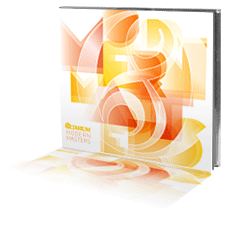
| 1 | Contre Qui, Rose | Morten Lauridsen | 3:43 |
| 2 | Set Me as a Seal | René Clausen | 2:59 |
| 2a | Four Valentines: A Lover’s Journey | Libby Larsen | |
| 3 | In the Still Garden | 3:05 | |
| 4 | St. Valentine’s Day | 4:49 | |
| 5 | Will You, Nill You | 1:06 | |
| 6 | Shall I Compare Thee | 3:25 | |
| 7 | A Boy and a Girl | 4:41 | |
| 8 | On Green Mountains World premiere recording, Octarium Composition Competition Winner |
Steve Danyew | 6:43 |
| 9 | Lo, How a Rose |
arr. Daniel Gawthrop | 4:08 |
| 10 | Double Shot |
Stephen Hatfield | 3:53 |
| 11 | Eyesight World premiere recording |
Steven Stucky | 4:06 |
| 12 | i carry your heart with me World premiere recording |
Stephen Paulus | 5:33 |
| 13 | Pied Beauty World premiere recording |
Mark Adamo | 3:41 |

